
Yellowed, brittle, and unusual-looking toenails may indicate a fungal nail infection, known as onychomycosis. Experts caution that these infections persist without intervention and can easily be transmitted from person to person. These types of infections can be contracted through close contact or from barefoot walking in communal areas like locker rooms. The fungus infiltrates toenails, thriving in moist, sweaty footwear. Toenail fungus affects roughly one in ten people globally, and is more prevalent with age, affecting over half of individuals aged 70 and older. People who have diabetes or compromised immune systems are particularly vulnerable. If you notice a change in your toenails, it is suggested that you schedule an appointment with a podiatrist for an evaluation, diagnosis, and treatment.
For more information about treatment, contact Stanley Luksenburg, DPM of Home Foot Care. Our doctor can provide the care you need to keep you pain-free and on your feet.
Toenail Fungus Treatment
Toenail fungus is a condition that affects many people and can be especially hard to get rid of. Fortunately, there are several methods to go about treating and avoiding it.
Antifungals & Deterrence
Oral antifungal medicine has been shown to be effective in many cases. It is important to consult with a podiatrist to determine the proper regiment for you, or potentially explore other options.
Applying foot powder on the feet and shoes helps keep the feet free of moisture and sweat.
Sandals or open toed shoes – Wearing these will allow air movement and help keep feet dry. They also expose your feet to light, which fungus cannot tolerate. Socks with moisture wicking material also help as well.
If you have any questions please feel free to contact our office located in Fairway Park, OH . We offer the newest diagnostic tools and technology to treat your foot and ankle needs.
 Regular foot check-ups are important for older adults to help identify potential problems early on. Getting treatment for any issues also prevents these problems from escalating into more serious conditions. As people age, changes in foot structure, skin integrity, and circulation can occur, making the feet more susceptible to various issues, such as pain and cracked heels. Regular check-ups become especially important for those with chronic conditions like diabetes or arthritis, as these can significantly impact foot health. Certain conditions, like plantar fasciitis and osteoarthritis, become more likely with repetitive movement and the natural wear and tear that comes with aging. Podiatrists can assess the risk of developing complications, provide personalized advice on footwear, and offer guidance on preventive measures. If you have concerns about your foot health as an older adult, or if you are experiencing foot pain, it is suggested that you schedule an appointment with a podiatrist.
Regular foot check-ups are important for older adults to help identify potential problems early on. Getting treatment for any issues also prevents these problems from escalating into more serious conditions. As people age, changes in foot structure, skin integrity, and circulation can occur, making the feet more susceptible to various issues, such as pain and cracked heels. Regular check-ups become especially important for those with chronic conditions like diabetes or arthritis, as these can significantly impact foot health. Certain conditions, like plantar fasciitis and osteoarthritis, become more likely with repetitive movement and the natural wear and tear that comes with aging. Podiatrists can assess the risk of developing complications, provide personalized advice on footwear, and offer guidance on preventive measures. If you have concerns about your foot health as an older adult, or if you are experiencing foot pain, it is suggested that you schedule an appointment with a podiatrist.
If you need your feet checked, contact Stanley Luksenburg, DPM of Home Foot Care. Our doctor will attend to all of your foot and ankle needs and provide you with quality treatment.
Geriatrics and Podiatry
When people age, some common issues that may occur are bone density loss, dry skin, poor circulation, and rough brittle nails. These issues may also affect your foot health if the necessary steps are not taken to alleviate the problems.
It is important to take care of your feet because feet that are injured or diseased can affect your overall health. Having painful feet hinders your ability to do daily activities or may decrease your willingness to do the things that you need to do.
Visiting Your Geriatrician
As we age, health problems become more likely, so it is essential to visit your doctor for check-ups to ensure that you are doing the best you can to take care of your health. It is recommended to check your feet frequently for any possible cuts, bruises, swelling, corns or any other irregularities.
Taking Care of Elderly Feet
Cracked or dry feet can be treated by applying moisturizer often. It is also important not to wear old socks because the older the sock is, the higher the possibility there will be that there is bacteria there. Wear fresh socks and make sure they fit properly.
Proper foot health means that you can have a more active lifestyle and you will not be bogged down by pain. Foot health also leads to good circulation, which is paramount for overall health.
If you have any questions, please feel free to contact our office located in Fairway Park, OH . We offer the newest diagnostic tools and technology to treat your foot and ankle needs.
 Corns can develop on many parts of the feet, although certain areas are more prone to corn formation due to increased pressure, friction, or rubbing against footwear. One common location for corns is on the tops of the toes, particularly over joints where the toe bones meet. The pressure from shoes that are too tight or narrow can cause friction in these areas. Similarly, corns may form on the sides of the toes, where adjacent toes rub against each other or against the sides of shoes. On the soles of the feet, corns often occur over bony prominences, such as the balls of the feet or the heels. Excessive pressure from walking or standing can cause thickened areas of skin to develop. Soft corns can also form between the toes due to moisture accumulation and friction. If you have corns on your feet, it is suggested you consult with a podiatrist who can provide more information about effective treatment and prevention.
Corns can develop on many parts of the feet, although certain areas are more prone to corn formation due to increased pressure, friction, or rubbing against footwear. One common location for corns is on the tops of the toes, particularly over joints where the toe bones meet. The pressure from shoes that are too tight or narrow can cause friction in these areas. Similarly, corns may form on the sides of the toes, where adjacent toes rub against each other or against the sides of shoes. On the soles of the feet, corns often occur over bony prominences, such as the balls of the feet or the heels. Excessive pressure from walking or standing can cause thickened areas of skin to develop. Soft corns can also form between the toes due to moisture accumulation and friction. If you have corns on your feet, it is suggested you consult with a podiatrist who can provide more information about effective treatment and prevention.
If you have any concerns regarding your feet and ankles, contact Stanley Luksenburg, DPM of Home Foot Care. Our doctor will treat your foot and ankle needs.
Corns: What Are They? and How Do You Get Rid of Them?
Corns can be described as areas of the skin that have thickened to the point of becoming painful or irritating. They are often layers and layers of the skin that have become dry and rough, and are normally smaller than calluses.
Ways to Prevent Corns
There are many ways to get rid of painful corns such as wearing:
- Well-fitting socks
- Comfortable shoes that are not tight around your foot
- Shoes that offer support
Treating Corns
Treatment of corns involves removing the dead skin that has built up in the specific area of the foot. Consult with Our doctor to determine the best treatment option for your case of corns.
If you have any questions please feel free to contact our office located in Fairway Park, OH . We offer the newest diagnostic and treatment technologies for all your foot and ankle needs.
